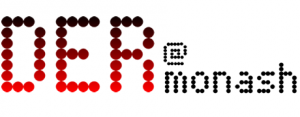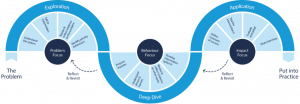When good pedagogy is only one of many possible ways to teach: How harnessing insights from behavioural science can improve teaching and learning practice.
Author information: Dr Filia Garivaldis, Senior Lecturer, Monash University
Despite having taught psychology for the majority of my career, it was not until I moved to BehaviourWorks Australia at the Monash Sustainable Development Institute, that I realised how readily the science of human behaviour and behaviour change could be applied to address some of our most pressing education challenges. And at a time when education is recognised as the single best investment a country can make to create prosperous, healthy, and equitable societies (United Nations, https://www.un.org/sustainabledevelopment/education/), harnessing what we know about why students and educators behave the way they do has never been more important. Yet, in higher education, there is a persisting assumption that students who register to complete a course of study have a minimum level of motivation that is enough to secure an impactful learning experience. This assumption can lead to the use of a familiar but narrow set of pedagogical solutions for addressing teaching and learning challenges.
Educators and students alike face a number of barriers associated with teaching and learning that interfere with the impact of even the most rigorously validated pedagogical, including digital, educational tools. Whilst enhancing knowledge and understanding is one way—an educator’s way—of inspiring change, it is not the only way, and not all education is done well. Within the continuously evolving educational landscape, a behavioural approach to optimising teaching and learning that complements the pedagogical approach, could provide new insights and validate existing knowledge, of how learners learn best.
Behavioural scientists are concerned with understanding human behaviour, from what prompts an individual to behave in a certain way, to how this behaviour can change, to create better outcomes for people and planet. There are many examples to draw from, where the application of behavioural science principles has improved economic prosperity, health, social inclusion and environmental sustainability (including specific reference to Covid-19). However, little known work has gone into examining the value of behavioural science in education.
Fortunately, there are a range of tools and techniques drawn from the best of behavioural science, that can be applied to any teaching and learning activity, to improve the chances of learning engagement. A growing body of literature is showing that simply providing learning content to learn is only one of many possible ways to teach.
Applying existing frameworks to improve teaching and learning
The EAST framework, from the Behavioural Insights Team UK, recommends four simple principles; including making priority behaviours, such as better study and teaching behaviours, EASY, ATTRACTIVE, SOCIAL and TIMELY, to increase their likelihood of adoption. The four EAST principles often appear in the education literature as ‘nudges’; techniques that encourage people to make certain decisions over others without coercion and without compromising freedom of choice. EAST can be applied to a range of existing and new behavioural and educational methods that involve doing things differently. Educators may use the EAST principles to compliment their education toolkit, to get the most out of their teaching efforts.
- Behaviours that are EASY tend to have a clear ‘call to action’, and can be readily performed without the need to navigate hurdles and intermediate steps. Learning can be made easy by changing default options, reducing friction costs, and simplifying instructions.
For example, students can be automatically opted-in to participating in certain key learning tasks, or into receiving notifications from their learning management system, can be provided with direct links to learning material to ensure easy access, or may be provided with instructions in step-by-step form to make key actions easier to follow.
- When a behaviour is ATTRACTIVE it is engaging and enjoyable, and may involve an incentive or reward. To make learning attractive, educators may use visual cues to draw attention, they may personalise messages, and offer incentives.For example, heavy text can be replaced with visuals to reduce monotony, personalised feedback on progress may be provided to students to prompt better performance or reward good performance, and learning can be made as fun as much as possible, to elicit positive emotions.
- Behaviour that is SOCIAL is influenced by others, such as how others behave, or how others expect us to behave. Learning can be made social through the use of credible individuals to communication messages, the sharing of progress to harness the power of positive social norms, and through increasing accountability for behaviours that need to be performed.For example, educators may use in-group members such as student representatives to support key messages, or show students how highly engaged others are in performing at the right level. Finally, students can be asked to pre-commit to learning activities as a way of increasing accountability to others.
- Lastly, a behaviour is TIMELY when it is situated or planned at a point in time that matters. Learning can be made timely by considering when students are most receptive to new information, the immediate costs and benefits of certain behaviours, and effective goal setting and planning.
For example, educators may take advantage of the start of a teaching cycle, when students are most receptive, to communicate key information, or send reminders and prompts for upcoming milestones, provide timely feedback, and help students identify a time and a place for engaging in study behaviour.
Applying a systematic approach to designing impactful education
Alternatively, a systematic approach to designing behaviour change solutions using well established frameworks, such as the BehaviourWorks Australia Method, can ensure a well-informed approach is applied to addressing specific behavioural challenges that may compromise teaching and learning outcomes. Such an approach specifies the tools and techniques that can be used at different stages of a behavioural campaign, to ensure that the problem and target audiences have been explored adequately, that the priority behaviour and what drives that behaviour is well understood, and that the solutions designed to change behaviour are fit for purpose.
Figure 1: The BehaviourWorks Australia Method
A behaviour change perspective to teaching and learning can enable educators to consider novel solutions to recurring educational challenges—i.e. solutions that are targeted and, when combined with sound pedagogy, have a greater chance of success. The assumption that simply providing students with information and knowledge of what they need to learn and how does not work. By using insights from the behavioural sciences, educators can create impactful educational products in ways that go beyond just information provision.
You can read more about the EAST framework here, and you can purchase a copy of the BehaviourWorks Australia Method book here



